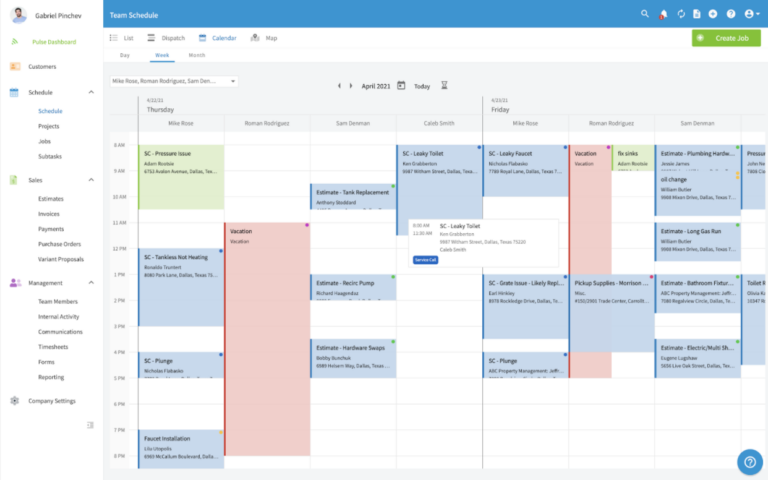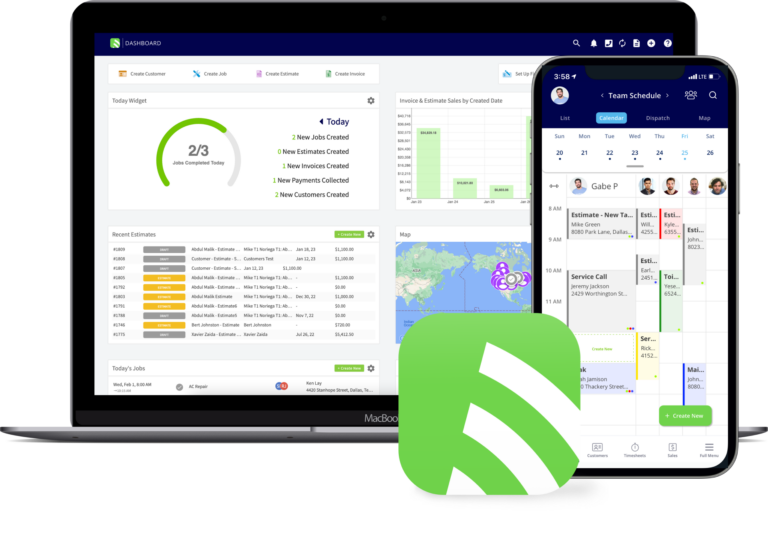Keeping tasks and deadlines top of mind is one of the best ways to ensure they get completed – and on time. Be sure to send customers reminder emails with your arrival information and how to prepare several times before you arrive: first, when they schedule the appointment, one day before the appointment, and when you’re on your way. This reminds customers they need to be at home and gives them time to clean up, put pets up, and make sure they have payment ready.
When sending out invoices, set up reminders and schedule time to go through invoices’ status weekly. Or get live updates through email, the app, or phone pop-up when invoices have been opened with the FieldPulse app.
Be sure to create clear deadlines, checkpoints, and ways to check in for everyone. This includes yourself, your managers, your technicians, and even your customers. This is a great way to ensure that everything is moving forward on schedule, and allows you to shift priorities should the need arise. Make your communication lines easy and quick enough to navigate so that employees can do it without too much thought or effort – or automate it!
When you own a business, it’s often easy to see administrative tasks as work to be done during downtime in the press of more facing issues. However, this makes it easy to let it fall to the wayside. Good idea to schedule a couple hours during the week to get everything in order. A small time investment can help streamline tasks during the week. One of the great benefits of having a consistent, organized system is that you can analyze its effectiveness over time. For example: Are you giving your clients too long to respond? Your calendar can show those weak spots.
It can be difficult to get employees to show up for work on time and obtain reviews and photos from customers. While you can create policies around this, incentives go further in motivating employees and can create a better positive experience instead of resentment that can lead to high turnover rates and low productivity.
Small prizes like gift cards to big ticket items like a vacation voucher, television, or AirPods can be a good way to incentivize performance, but there are many ways to design incentive programs, such as the following.
It costs businesses about one-fifth of a worker’s salary to a worker between the cost of hiring, slower productivity as the new employee is trained, and the overall impact on other employees. It’s important to keep employees motivated and offer incentives, as the expense pays for itself in the long run.
A few ideas to increase employee retention include offering:
Before deciding on disciplinary actions, you’ll want to familiarize yourself with what actions you can legally take to discipline employees. For example, levying fines or requiring uncompensated overtime, such as for additional training, is illegal. While demotions, suspensions without pay, and payroll reductions are all legal in response to poor performance, this often needs to be explicitly defined in your employment contract and explained to your employees before hiring. Even then, you’ll want to consult with a lawyer and keep detailed records of employee behavior to protect yourself should you end up in a legal battle over discriminatory practices.
If an employee is performing negatively, start by determining the fault. Was it an issue they could actually control, or something larger than their position? Did the employee not understand their responsibilities or how they were supposed to handle the situation that arose? An example of this would be telling an employee to “show up on time” is unclear, instead you would say that they need to be “in the front office at 9am”.
Address any issues early on – start the process early enough you can start it as a conversation instead of a lecture and resolve potential issues. When this happens, there is no need to voice consequences of actions if the behavior or poor performance continues. Be specific about what the employee did wrong and what steps the employee needs to do to improve. Describe the conduct, not the employee, and avoid using broad judgements like “always” or “never” (which can be easily disputed by the employee’s attorney).
Record the date, where it happened, how the behavior impacted others, and try to provide a well rounded picture that includes what employee did right. Record the employee’s explanation of why expectations weren’t met, and work together to find ways to solve the problem. Make clear performance improvement plans for your employee, and document them with deadlines.
There are a number of ways to deliver this feedback, including written and oral warnings, but you should absolutely document and save them all.
As a rule, you should always fire employees face to face unless you have a reasonable fear of safety for you, your employees, or company property. In these cases, you’ll want to establish any necessary security measures before calling the employee to let them know they’re being let go of. The firing should be held in private to avoid negative impact on employee morale with a witness present, such as an HR representative, who can take notes on the event. Be clear and concise delivering the news upfront to avoid potential misunderstandings. Be sure to address final pay and benefits. You should also recap the reasons for the termination, incidents that contributed to the decision, and record state specific dates of meetings with the employee and attempts to provide additional training or coaching. Be specific – “bad attitude” or “culture fit” are often used as grounds for lawsuit.
Verify that you have the correct mailing address so you can send final pay (if applicable), a Form W-2, and any other correspondence to the individual. Also, ask the employee to notify you if he or she has a change in address. Federal law requires final pay at the next regular payday, but several states have their own rules, some of which require final pay at the time of termination. Non-exempt employees (employees who are entitled to minimum wage and overtime), the Fair Labor Standards Act (FLSA) permits deductions for unreturned equipment as long as it does not reduce the employee’s pay below the minimum wage and does not cut into any overtime pay. Under the FLSA, employers are generally required to obtain an employee’s consent before making a permissible deduction.
First, notify key staff like HR or administration who have to terminate employees’ login or file paperwork. Next, after the employee has been let go of, inform staff about changes and how it will impact them. It’s a good idea to be specific about why the employee was let go when discussing with staff.
Now that we’ve covered all of the basics of employee management, you’re ready to start streamlining and putting processes in place. While you may not think it’s necessary to hire an HR professional when you’re just starting out, we’d highly recommend doing so. This will help to shift all the employee record keeping off your shoulders, so you can spend more time focusing on other aspects of your business.


